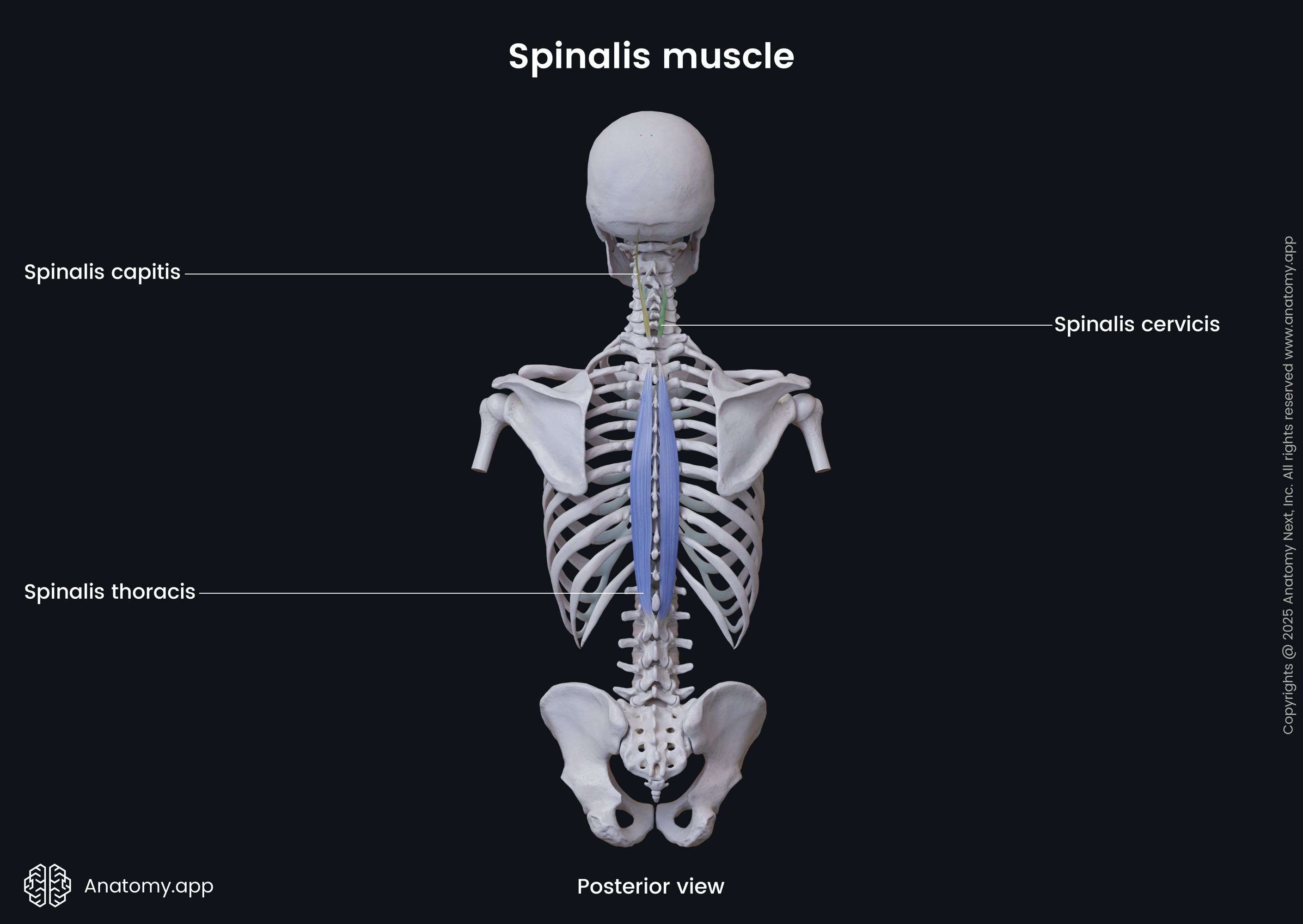- Anatomical terminology
- Skeletal system
- Joints
- Muscles
- Head muscles
- Neck muscles
- Muscles of upper limb
- Thoracic muscles
- Muscles of back
- Superficial back muscles
- Intermediate back muscles
- Deep back muscles
- Superficial layer
- Intermediate layer (Erector Spinae)
- Deep layer (Transversospinales)
- Deepest layer
- Muscles of lower limb
- Heart
- Blood vessels
- Lymphatic system
- Nervous system
- Respiratory system
- Digestive system
- Urinary system
- Female reproductive system
- Male reproductive system
- Endocrine glands
- Eye
- Ear
Spinalis
The spinalis (Latin: musculus spinalis) is one of the muscles forming the erector spinae - a muscle complex consisting of several smaller intrinsic deep back muscle groups that all together form the intermediate layer of the deep back muscles. The other two groups are the longissimus and iliocostalis muscles. The erector spinae muscles run along the length of the spine, and the spinalis is the most medial of the three erector spinae muscles.
The spinalis mainly stretches between the spinous processes of the cervical and thoracic vertebrae, although its upper aspect is also attached to the occipital bone. The spinalis muscle is composed of three parts, and all portions are named based on their location - spinalis capitis, spinalis cervicis and spinalis thoracis muscles. All parts share one common feature - they are innervated by the lateral branches of the dorsal rami of the spinal nerves.

Spinalis capitis
| Spinalis capitis | |
|---|---|
| Origin | Spinous processes of C7 - T1 vertebrae |
| Insertion | Occipital bone between superior and inferior nuchal lines |
| Action | Bilateral contractions - extension of head and neck Unilateral contractions - ipsilateral lateral flexion of cervical spine |
| Innervation | Lateral branches of dorsal rami of spinal nerves |
| Blood supply | Vertebral, deep cervical and occipital arteries |
Origin
The spinalis capitis muscle originates from the spinous processes of the seventh cervical to first thoracic vertebrae (C7 - T1).
Insertion
The spinalis capitis inserts between the superior and inferior nuchal lines on the occipital bone of the skull.
Action
Muscle contractions on both sides (bilateral contractions) extend the head and neck, while contractions on one side (unilateral contractions) provide lateral flexion of the cervical spine to the same side (ipsilateral).
Innervation
The spinalis capitis is innervated by the lateral branches of the dorsal rami of the spinal nerves.
Blood supply
The spinalis capitis muscle receives arterial blood supply from the branches of the vertebral, deep cervical and occipital arteries. The vertebral artery is a branch of the subclavian artery, while the deep cervical artery arises from the costocervical trunk. And finally, the occipital artery branches off the external carotid artery.
Spinalis cervicis
| Spinalis cervicis | |
|---|---|
| Origin | Spinous processes of C7 - T1 vertebrae, nuchal ligament |
| Insertion | Spinous processes of C2 - C4 vertebrae |
| Action | Bilateral contractions - extension of head and neck Unilateral contractions - ipsilateral lateral flexion of cervical spine |
| Innervation | Lateral branches of dorsal rami of spinal nerves |
| Blood supply | Vertebral, deep cervical and occipital arteries |
Origin
The spinalis cervicis muscle originates from the spinous processes of the seventh cervical to first thoracic vertebrae (C7 - T1) and the nuchal ligament.
Insertion
The fibers of the spinalis cervicis insert on the spinous processes of the second to fourth cervical vertebrae (C2 - C4).
Action
Muscle contractions on both sides (bilateral contractions) extend the head and neck, while contractions on one side (unilateral contractions) provide lateral flexion of the cervical spine to the same side (ipsilateral).
Innervation
The spinalis cervicis is innervated by the lateral branches of the dorsal rami of the spinal nerves.
Blood supply
The spinalis cervicis muscle receives arterial blood supply from the branches of the vertebral, deep cervical and occipital arteries. The vertebral artery is a branch of the subclavian artery, while the deep cervical artery arises from the costocervical trunk. And finally, the occipital artery branches off the external carotid artery.
Spinalis thoracis
| Spinalis thoracis | |
|---|---|
| Origin | Spinous processes of T11 - L2 vertebrae |
| Insertion | Spinous processes of T2 - T8 vertebrae |
| Action | Bilateral contractions - extension of thoracic spine Unilateral contractions - ipsilateral lateral flexion of thoracic spine |
| Innervation | Lateral branches of dorsal rami of spinal nerves |
| Blood supply | Superior and posterior intercostal arteries |
Origin
The spinalis thoracis muscle arises from the spinous processes of the eleventh thoracic to second lumbar vertebrae (T11 - L2).
Insertion
The thoracic part of the spinalis muscle inserts on the spinous processes of the second to eight thoracic vertebrae (T2 - T8).
Action
Muscle contractions on both sides (bilateral contractions) extend the thoracic spine, while contractions on one side (unilateral contractions) provide lateral flexion of the thoracic spine to the same side (ipsilateral).
Innervation
The spinalis thoracis is innervated by the lateral branches of the dorsal rami of the spinal nerves.
Blood supply
The spinalis thoracis muscle receives arterial blood supply from the branches of the superior and posterior intercostal arteries. The superior intercostal arteries are branches of the costocervical trunk, while the posterior intercostal arteries arise from the superior intercostal arteries and thoracic aorta.